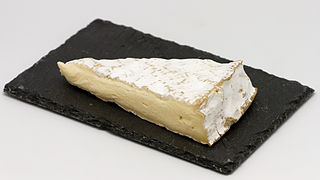
Brie is a soft cow's-milk cheese named after Brie, the French region from which it originated. It is pale in colour with a slight greyish tinge under a rind of white mould. The rind is typically eaten, with its flavour depending largely upon the ingredients used and its manufacturing environment. It is similar to Camembert, which is native to a different region of France. Brie typically contains between 60% and 75% butterfat, slightly higher than Camembert.

Camembert is a moist, soft, creamy, surface-ripened cow's milk cheese. It was first made in the late 18th century in Camembert, Normandy, in northwest France. It is sometimes compared in look, taste and texture to brie cheese, albeit with a slightly lower butterfat content than brie's typical 20% – 25% by weight.

Brie de Meaux is a French brie cheese of the Brie region and a designated AOC product since 1980. Its name comes from the town of Meaux in the Brie region. As of 2003, 6,774 tonnes were produced annually.
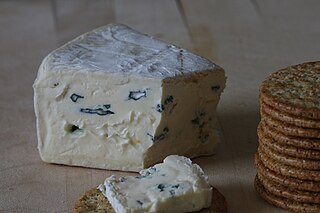
Cambozola is a cow's milk cheese that is a combination in style of a French soft-ripened triple cream cheese and Italian Gorgonzola.

Saint-André is a brand of French triple cream cow's milk cheese with a powdery white, bloomy skin of mold, in the form of a 200 g (7.1 oz) cylinder, 6 cm in diameter and 5 cm high. Originally developed and manufactured by the industrial Soulié cheese factory in Villefranche-de-Rouergue, Aveyron,. it is now produced in Vire, Calvados. It has a soft buttery texture, tangy edible rind, and tastes like an intense version of Brie. Cream is added to the cheese during manufacture. The curing process lasts approximately 30 days. The fat content of Saint-André is so exceptionally high it can make a white wine taste sour and metallic; the manufacturer recommends a crust of baguette and a light beer or simply a slice of pear as more appropriate complements. Oaked Chardonnay wines, which tend to be low in acidity, have been reported to be able to complement Saint-André.
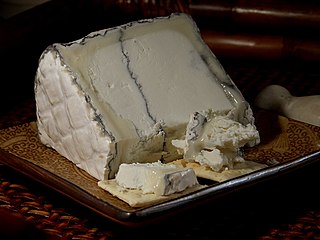
Humboldt Fog is a goat milk cheese made by Cypress Grove, of Arcata, California, in Humboldt County. It is named for the local ocean fog which rolls in from Humboldt Bay. It is an uncooked pressed cheese made from pasteurized goat's milk.

Neufchâtel is a soft, slightly crumbly, mold-ripened, bloomy-rind cheese made in the Neufchâtel-en-Bray region of Normandy. One of the oldest kinds of cheese in France, its production is believed to date back as far as the 6th century AD, in the Kingdom of the Franks. It looks similar to Camembert and Brie, with a dry, white, edible rind, but the taste is saltier and sharper. Unlike other soft-white-rinded cheeses, Neufchâtel has a grainy texture. It is usually sold in heart shapes but is also produced in other forms, such as logs and boxes. It is typically matured for 8–10 weeks and weighs around 100–600 g (3.5–21.2 oz).
Caravane, also known as Camelbert, is the brand name of a camel milk cheese produced in Mauritania by Tiviski, a company founded by Nancy Abeiderrhamane in 1987. A brie-like cheese, its availability is largely limited to Mauritania, and as an export to neighboring Senegal.

Coulommiers is a soft ripened cheese from Coulommiers, Seine-et-Marne, France. It is made from cow's milk, and is usually in the shape of a disc with white, bloomy, edible Penicillium candidum rind. When produced as an artisanal or "farmhouse" cheese from unpasteurized milk, it has some reddish blush in parts of the rind. The period of ripening when made of pasteurised whole milk is about four to six weeks. The fat content is 40 per cent.

Geotrichum candidum is a fungus which is a member of the human microbiome, notably associated with skin, sputum, and faeces where it occurs in 25–30% of specimens. It is common in soil and has been isolated from soil collected around the world, in all continents.
Norbury Blue is an English blue cheese made in Surrey. It is entirely handmade and the only blue cheese made in the South of England with milk from a closed herd of Friesian cows, fed on GM-free fodder. The cheese was made at the Dairy at Norbury Park Farm until 2018, when production moved to Sherbourne Farm at Albury.
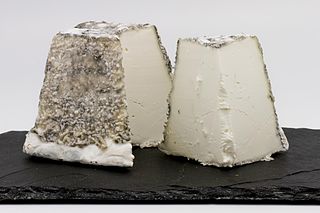
There are many different types of cheese. Cheeses can be grouped or classified according to criteria such as length of fermentation, texture, methods of production, fat content, animal milk, and country or region of origin. The method most commonly and traditionally used is based on moisture content, which is then further narrowed down by fat content and curing or ripening methods. The criteria may either be used singly or in combination, with no single method being universally used.
Höfðingi is a type of Icelandic cheese, described as a "creamy-soft, almost runny cheese with a white rind/crust and a smooth, mild flavor." It has been described as similar to brie cheese.
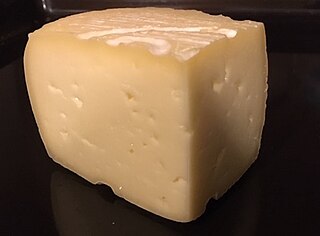
Rosa Camuna is an Italian mild semi-hard paste cheese made with partially skimmed cow's milk. Its shape and name come from the Camunian rose of Val Camonica where the cheese is produced. It has an ivory white color inside with uniformly spaced tiny eyes, and a soft bloomy rind. It has a mild taste and melts very well.

Délice de Bourgogne is a French cow's milk cheese from the Burgundy region of France. It was first created in 1975 by Jean Lincet at Fromagerie Lincet. It is a triple cream cheese. The high fat content results from the extra cream that is added during the cheese-making process. Small rounds are aged for one week, and can also be considered of the type Brillat-Savarin; larger ones are aged for two weeks or more.
Kunik is a brand of cow and goat milk cheese. It is described by the producer as a semi-aged, triple cream wheel cheese made from 25% Jersey cow cream and 75% goat's milk. It has an edible, bloomy white rind; a tangy, buttery flavor; and a thick, smooth, creamy texture. The addition of high-milkfat Jersey cow cream makes the cheese more rich and flavorful than a brie cheese, but less pungent than a pure goat cheese. Anne Saxelby, reviewing the cheese for Esquire, stated "it may very well be the sexiest cheese in the U.S.A."

Delice d'Argental is a triple cream French cheese from the Burgundy region. It is made by hand from cow's milk. The addition of crème fraîche to the curds during manufacture provides for extra richness - developing an exceptionally creamy texture. This cheese has a soft bloomy rind which is yellow-white in colour. It is similar to Brie both in appearance and texture.
Cornish Brie is a type of brie-style, soft, white-rinded British cheese from Cornwall, England. Cornish brie is made by several dairies and has won a number of awards.
Bath Soft Cheese is a traditional, soft-white cheese made from pasteurised cow's milk. Originating from southwest England, it belongs to the Brie family of cheeses. It has a creamy texture and a bloomy rind. It is produced in Kelston, near Bath. The flavor of Bath Soft Cheese is earthy, mushroomy, and citrusy, with a grassy, aromatic scent.












